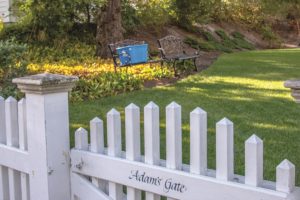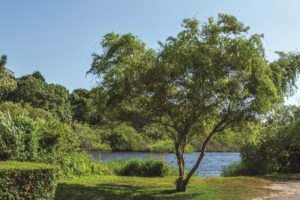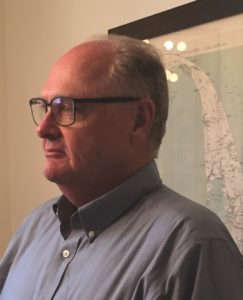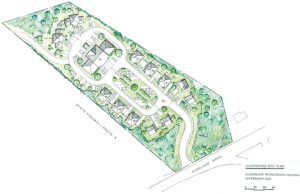TRURO — It took five months and a handful of major tweaks, but the zoning board of appeals voted Monday to allow Tom and Kathleen Dennis of Springfield to move the building they call the “Boathouse” from its original location at 133 South Pamet Road to a nearby property they recently purchased at 127 South Pamet. The approval came with a handful of conditions.
Among them is that the Boathouse be moved by June 10; that it not be connected to utilities or given an occupancy permit until an existing studio at 127 South Pamet is removed; that the studio be gone by Oct. 15; that no short-term rentals of the property take place after this summer; and that the Dennises comply with all conservation commission requirements.
The Dennises purchased 127 South Pamet on Dec. 17 for $2.34 million with the intention of using it as the new site of the Boathouse, which was already teetering on the bluff. Before they could secure the necessary permits, a January storm forced its emergency relocation to a spot straddling the rear of 133 and a neighbor’s property, where it has remained while the Dennises continued to seek permission for the move to 127. The entire area is inside the Cape Cod National Seashore.
The biggest obstacle has been the town’s zoning bylaw, which prohibits more than one dwelling per lot. The 127 South Pamet property already has a house on it as well as a “habitable studio,” which was added in 2007 and is classified as an “accessory building,” not a dwelling.
At a hearing in January, Ben Zehnder, the Dennises’ lawyer, suggested that the kitchen could be removed from the Boathouse to make it an accessory building rather than a dwelling. Lauren McKean, the National Seashore’s planner, objected that the property already had one accessory building; only one is allowed.
Without taking action in January on either the variance or special permit applications, the ZBA continued the hearing on relocating the Boathouse for 90 days, at the request of the applicant.
On Monday, Zehnder presented a proposal that had been tweaked yet again, this time suggesting that the existing studio be demolished or taken off the 127 South Pamet property, making the Boathouse, with its kitchen removed, the sole accessory building.
It would be a simple switch of one “habitable studio” for another, Zehnder said, and would eliminate the need for some of the previously requested zoning relief. Removing the studio would place the plan within the gross floor area allowed by right in the National Seashore district. The total floor area of the main dwelling and the Boathouse total 3,199 square feet. Up to 3,666 square feet is allowed in the Seashore district on a 3.3-acre lot, Zehnder said.
All the Dennises needed for their new plan, the lawyer said, was a special permit for alterations on a pre-existing nonconforming lot.
Clyde Watson, whose property abuts 127 South Pamet, expressed concerns about the proposal in a letter. Watson warned that the issuance of any special permits or variances would “establish an extraordinary precedent in the entire Seashore zone from Provincetown to Chatham.” She went on to cite potential damage to the dune and surrounding environment.
“The new plan proposes a total of six significant environmental disturbances to this fragile area,” Watson wrote.
Zoning board member Darrell Shedd and alternate Curtis Hartman were also concerned about the dune. “This is a lot of construction and deconstruction,” Shedd said. “I don’t understand why 127 can’t stay the way it is, and 133 moved to another location.”
Zehnder reminded the board that the conservation commission had already approved “a very comprehensive plan to move the Boathouse” and would set requirements related to the removal of the studio as well.
The purview of the zoning board, he said, was to determine whether the Dennises’ proposal would be more detrimental than what is currently on the 127 South Pamet property. He argued that the result would be less detrimental. The studio, which is at the highest elevation on the site, would be removed. Moving the Boathouse would preserve a historic structure.
“If the board looks at the scale, massing, and viewshed, I don’t think the board would find it substantially detrimental,” Zehnder said. “You’re ending up with one of the most responsibly managed projects. It’s better than what’s there now.”
One sticking point for the board was that the studio and Boathouse would both be on the site until the Dennises secured what they needed from the conservation commission to move or demolish the studio. The presence of both would boost the gross square footage beyond the allowable amount temporarily.
Zehnder suggested a condition on the special permit: that the Boathouse can’t be connected to utilities or issued an occupancy permit until the studio is removed.
Zehnder noted that the previous owner was given the right to rent the house and studio on the property this summer as part of the sale. As soon as the rental season ends, the studio would be removed, he said.
Board chair Arthur Hultin urged approval of the permit. “This isn’t outside of what the zoning board can and should allow in special cases,” he said.
The board granted the special permit, with Hartman casting the only opposing vote. Truro’s town planner and land use counsel Barbara Carboni will write up the formal list of conditions that will be attached.
The Boathouse played a large role in the town’s history. Built in about 1885, the one-and-a-half-story building housed rescue boats for the former Pamet Life Saving Station. Around 1945, it was converted to a residence.
The Dennises own three houses on Ballston Beach as well as six other houses in town. Among them is the former Kline house at 27 Stephens Way.






 One of the callers, Regan McCarthy, former president of the Truro Part-Time Resident Taxpayers Association, said people are too intimidated to speak out.
One of the callers, Regan McCarthy, former president of the Truro Part-Time Resident Taxpayers Association, said people are too intimidated to speak out.

